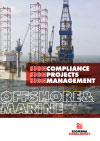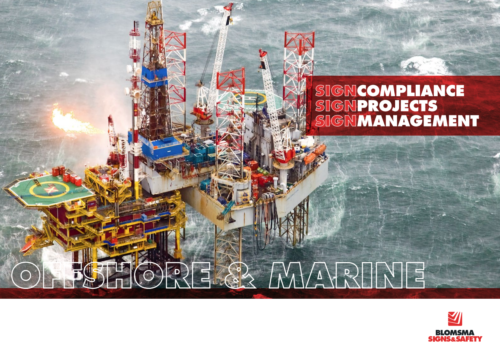- Markets
- Products
- Our work
- Downloads
- Standards and Laws
- Nieuws
- About us
- Contact
The offshore sector is a world of extremes, a diversity of activities from energy extraction, storage and research. A sector in the midst of the extensive energy transition and at the same time the challenges of maintaining installations in a mature oil and gas extraction market.
Shifting from the extraction of hydrocarbons to new forms of energy extraction such as offshore wind energy, hydrogen production and storage of CO2 is the trend that now dominates this market. A coordinated process of operations for supply, maintenance and daily profitable operation of offshore installations, transportation of extracted energy and fuels to onshore locations and impressive installations and construction equipment color this sector.
The compact, efficient nature of the installations, the extreme weather conditions and specific risks make high demands on safety and quality. Targeted and comprehensible information and instruction are a must in this market. It is a sector in which a safety signage system is at its best as a means of communication and prevention.
Blomsma Signs & Safety has a rich history in this world of extremes. For several decades we have been involved as experts in functional signage solutions and systems for offshore installations and structures. We know how safety signage comes into its own and that planned customization should prevent a complex and inefficient set of stickers and signs. We link relevant requirements from legislation with practical, understandable applications. A Fit for Purpose strategy is a system of signs with a specific functionality that contribute to safe operation, living and working on offshore installations and objects. Our knowledge and experience is widely applied in the oil and gas industry, offshore wind energy, CCS (Carbon Capture Storage) and at measuring and research stations. Blomsma realizes the marking of complete piping systems on FPSO’s to identification panels and warning markings on monopiles and transition pieces of offshore wind turbines.
On this page you will find the following topics:

In our Offshore & Marine brochure you can read more about our products and services in the field of safety signs and identification solutions in the offshore sector.
Brochure Offshore & MarineThe offshore sector has to deal with requirements and regulations from various angles. On our Standards and Laws page, you will see a pre-selection of standards and laws that are tangential to safety signage and identification.
For the offshore sector, a composition of international (maritime) legislation (IMO/Solas, EU Directives), international (ISO/OSHA) standards and national legislation applies, the latter mainly in the field of working conditions. Recent publications of ISO standards such as the ISO 24409 and the ISO 7010 provide a uniform globally applicable signage requirement.
“The growth of international travel by ship has created a need to provide people travelling an dworking on board ships with signs and associated systems that communicate consistent and effective safety information. This international standard specifies a system of safety and safety related signs on ships and other marine installations that is generally consistent with standardized signs with which many will have gained familiarity in other applications” - ISO 24409-1:2010
Offshore installations and objects are provided with clearly recognizable identification all around. This is laid down in general terms in the regulations. The implementation is virtually the same everywhere, with legibility and visibility as goals. Offshore objects must be legible for ships and helicopters from greater distances. Clear identification panels help prevent so-called ‘wrong deck landings’.
Blomsma Signs & Safety, in collaboration with 3M, has developed various sustainable solutions for maximum visibility and longer life. Both panels with a high reflective value and practical foils for application directly to the wall of a monopile or a transfer piece.
Our platform Identification panels have been applied on various offshore installations worldwide. For example on the Aasta Hansteen of Equinor (Statoil). More about this project can be read in the project case.
View project case Aasta HansteenOffshore installations are characterized by their compact and practical construction and are surrounded by sea. Evacuation differs here from onshore installations, evacuation of an offshore installation is done by means of lifeboats and helicopters. Clear marking of the various routes to assembly points and evacuation points are even more essential on these installations than on onshore locations. In the event of an emergency, escape, muster and evacuation must take place immediately and efficiently.
International standards provide guidance for an understandable and uniform implementation of escape route signage. The standards provide a practical translation of legislation. For escape route marking, symbols are used according to ISO 7010 and an escape route guidance system (low location lighting) is installed according to ISO 15370. Evacuation plans are produced according to ISO 23601.
“In addition to the emergency lighting, the means of escape in accommodation areas, including stairways and exits should be marked by lightning or photoluminescent strip indicators placed not more than 300mm above the deck at all point of the escape route, including angels and intersections” - IMO Resolution A.1023(26) Article 9.4.1.4
Marking firefighting and rescue resources is a visual aid for quick identification of the location of the resources in question. Offshore, more is expected of employees, such as self-extinguishing a small incipient fire. Being able to quickly locate extinguishing and rescue resources is an absolute must here. The symbolism and position of the signage is uniform with the fire & safety plans.
On offshore installations there are safety zones and risky areas outside the accommodation. Marking of the beginning of the safety zone is done on entrances from the accommodation or on arrival of the installation. Areas and installation parts with an increased or specific risk are marked locally with signs and additionally with partitions or floor marking. Areas with increased risk are, for example, plant parts containing H2s, installations that start automatically, storage of chemicals or noise areas.
The refurbishment of the Gryphon A FPSO was perhaps one of the most challenging projects in the field of safety signage. A project with a short deadline, new and old installation parts, and an implementation of a complete signage system in a versatile and complex environment.
View project case Gryphon A FPSOUnderstanding the process contributes to the safe and efficient start-up, operation and maintenance of offshore installations. Understandable and clearly identifiable markings and signs can prevent errors. In compact and complex systems on offshore installations, pipe markings give operators, maintenance staff, inspection and testing services a valuable source of information. For example, it depicts the substance name, medium group the hazards and any process information such as a pipe number. It reduces the search for fittings and pipes. Legislation even makes the marking of pipes with hazardous properties a requirement. The ISO 20560-1 is making its appearance as an international harmonized standard, also for the offshore industry. In addition, there are also the ISO 14726, NORSOK and DIN 2403 which are used in the maritime and offshore (wind) sector.
Quality in the field of pipe marking is an absolute must in the offshore sector with strong weather and saltwater influences. You can read more about this in our White Paper ‘Quality aspects of pipe marking’.
Tanks, vessels and process equipment are marked with tag numbers and specific technical data. A wide range of proven materials are used in our process identification projects.
An overview of our practical tapes in the offshore & marine sector can be found in this brochure.
A complete project where both safety signage and specialist pipe marking (according to NORSOK) and process identification has been realised is the Oseberg Vestflanken Topside.
View project case Oseberg VestflankenThe offshore sector has been a driver in the development of sustainable anti-slip solutions. Anti-slip stair treads and anti-slip walkway covers are standard features on offshore installations. Lightweight and rock-solid FRP anti-slip solutions are applied to grating floors and stair treads. A comprehensive range of high quality 3M™ SafetyWalk™ anti-slip tapes help to prevent incidents due to slips and falls.

Our Offshore & Marine Portfolio features many inspirational images for functional sign solutions and applications.
Portfolio Offshore & Marine SignageWant to know more?
Contact us.